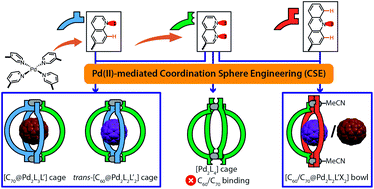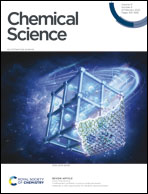Cooperativity of steric bulk and H-bonding in coordination sphere engineering: heteroleptic PdII cages and bowls by design†
Abstract
Recently developed self-assembly strategies allow to rationally reduce the symmetry of metallosupramolecular architectures. In addition, the combination of multiple ligand types without creating compound mixtures has become possible. Among several approaches to realize non-statistical heteroleptic assembly, Coordination Sphere Engineering (CSE) makes use of secondary repulsive or attractive interactions in direct vicinity of the metal nodes. Previously, we used steric congestion to turn dinuclear [Pd2L4] cages with fourfold symmetry into [Pd2L3X2] (X = solvent, halide) bowl structures. Here, we introduce a new subtype of this strategy based on balancing hydrogen bonding and repulsive interactions between ligands carrying quinoline (LQu) and 1,8-naphthyridine (LNa) donors to generate trans-[Pd2L2 ] and [Pd2L3L′] cages, assisted by templation of encapsulated fullerenes. Combined with steric congestion caused by acridine (LAc) donors, we further report the first example of a heteroleptic [Pd2L2L′X2] bowl. Formation, structure and fullerene binding ability of these metallo-supramolecular hosts were studied by NMR, mass spectrometry and single crystal X-ray diffraction.
] and [Pd2L3L′] cages, assisted by templation of encapsulated fullerenes. Combined with steric congestion caused by acridine (LAc) donors, we further report the first example of a heteroleptic [Pd2L2L′X2] bowl. Formation, structure and fullerene binding ability of these metallo-supramolecular hosts were studied by NMR, mass spectrometry and single crystal X-ray diffraction.

- This article is part of the themed collection: Most popular 2022 supramolecular chemistry articles


 Please wait while we load your content...
Please wait while we load your content...